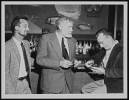Copa Girls kick off four-part Sands salute
Look up “copacetic” in the dictionary and you’ll get the formal definition: “very satisfactory.”
But you won’t find the Vegas variation: Copa-cetic.
Starting Saturday, everything’s Copa-cetic — not to mention Copa-centric — as the first of four public history programs celebrates the history and mystique of the Copa Room, the legendary Sands hotel-casino’s equally legendary showroom, which lives on in our collective pop-culture memory as Rat Pack headquarters.
Presented by the Junior League, Saturday afternoon’s free “Meet the Copa Girls” reception — which kicks off a four-part “Sands Copa Connection” series — provides an open-house opportunity for locals to meet, chat with, and share memories of the Strip’s most glamorous “Place in the Sun.”
Extending the Copa connection, the reception takes place at the Junior League’s historic Morelli House — which was, once upon a time, the home of Antonio Morelli, who led the Copa Room orchestra from 1954 to 1972. (A pristine example of the 1950s architectural style now known as “mid-century modern,” the Morelli home was relocated downtown from the Desert Inn Country Club Estates, now home to Wynn Resorts.)
The former Copa Girls will share memories — along with scrapbooks and photographs recapturing the Copa Room’s heyday. Visitors attending Saturday’s reception (and the three other Sands events) will receive souvenir commemorative scrapbooks. (Photographs featured at the reception also will be on display Saturday night in The Smith Center’s Reynolds Hall lobby, in conjunction with the Las Vegas Philharmonic’s 7:30 p.m. “vintage Vegas” pops concert featuring Rat Pack favorites originally recorded by Frank Sinatra, Dean Martin and Sammy Davis Jr.)
Other Strip casinos may have had their all-star headliners, but “the Sands was special,” according to Las Vegas historian Michael Green, professor at the College of Southern Nevada. “It is the hotel we associate with the Rat Pack — and we associate the Rat Pack with a lot of the things” that have come to symbolize classic Vegas, including “the idea of their boyishly adult behavior.”
With drinks in their hands and cigarette smoke haloing their heads, the Rat Pack — Sinatra, Martin and Davis, along with actor Peter Lawford and comedian Joey Bishop — “seemed to represent to many what being cool was all about,” Green explains.
Former Copa Girl Judy Johnson Jones — who’s returning to Las Vegas from her home in Manassas, Va., for Saturday’s reception — remembers it well.
“The mystique was the Rat Pack and the feeling they brought,” she says in a telephone interview, recalling how “the tension rose and the excitement” built when the boys were back in town.“Everything was sort of normal, ho-hum fun when they weren’t there,” according to Jones, but if the Rat Pack was expected, the Sands went on “high alert.”
As for how the Rat Pack wound up at the Sands in the first place, the credit goes to entertainment director Jack Entratter, a showbiz whiz who came to Las Vegas from New York’s renowned Copacabana nightclub. Entratter “had deep ties to big entertainers,” Green notes, and “because of Entratter’s connections, the Sands had that little something extra” rival resorts didn’t.
As a result, Entratter “raised the level of entertainment in the showrooms,” observes Dedee Nave, program director or the Junior League’s Copa Connection series, extending the Copa’s renown to movies (such as the original 1960 Rat Pack romp “Ocean’s Eleven”) and TV specials.
Big headliners in turn brought out big Hollywood names. Cary Grant’s mere presence ringside disrupted the opening number one night, when someone caught sight of the screen idol and said, “ ‘There’s Cary Grant,’ prompting her fellow Copa Girls to respond, ‘Where, where,’ and we’d bang into one another,” Rusty Taylor Feuer says.
Jones remembers the night Entratter waved her over to the lounge so she could join him and his guest: legendary leading man Gary Cooper, who was “so sweet and funny,” she recalls.
Martin, meanwhile, was best man at Joy Blaine Garner’s wedding to pop singer (and pro golfer) Don Cherry — and later came to visit her while she was hospitalized, which prompted “great treatment” from the nursing staff afterward.
And though every Strip showroom had its resident showgirls, the Copa Girls had their own special glamour. After all, “you don’t immediately think of the Desert Inn showgirls,” Green points out. “We knew who the Copa Girls were.”
Entratter “was looking for a certain look — a typical American, wholesome, beauty contest winner. He didn’t really care if you could dance or not. If you could walk, that was enough,” Jones says.
When Corinne Entratter Sidney left a Hollywood acting career (where she was billed as Corinne Cole) for Las Vegas, she told her future husband, “I don’t dance, I walk.” But that walking included “10-foot headgear” and “spectacular gowns” made of “the finest material.”
And whenever she walked out on stage, Sidney extended her arms in a “Ta-daaa!” pose, pondering her “inner monologue,” as she had learned in her acting studies. “My inner monologue was: Eat your hearts out!”
One costume Garner wore — a gold lame bridal gown — “got a big hand every night,” she recalls. (Garner’s daughter later captioned a photograph of her mother in costume as “ ‘When my mom was married to Henry VIII,’ ” Garner recalls with a laugh.)
Off stage, according to Jones, “we were supposed to just be around and decorate the place.”
Overall, “it was one of those jobs — what’s the old line? — where I would have paid them” to work as a Copa Girl, Garner admits. “You live your life and you don’t think about it, but gee, we really had a lot of fun.”
Contact reporter Carol Cling at ccling@reviewjournal.com or 702-383-0272.




























